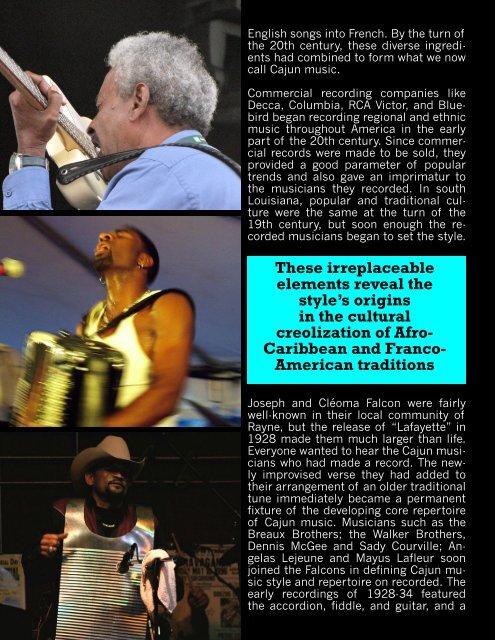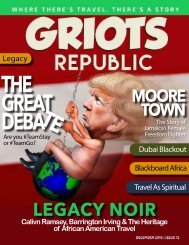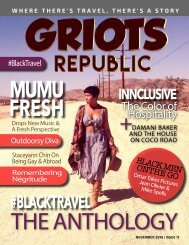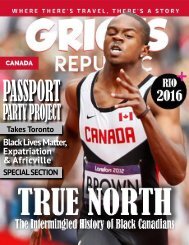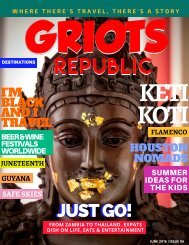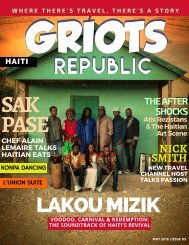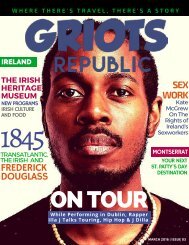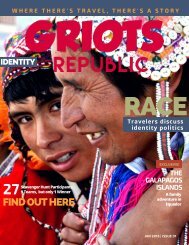GRIOTS REPUBLIC - AN URBAN BLACK TRAVEL MAG - JULY 2016
ISSUE #7: GLOBAL MUSIC In this issue we've covered global black music all around the world. Black Travel Profiles Include: Jazz Vocalist, Andromeda Turre; Conductor from Orchestra Noir, Jason Rodgers; Reggae Legend, Tony Rebel; & Miami Band, Batuke Samba Funk! For more black travel profiles and stories, visit us at www.GRIOTSREPUBLIC.com.
ISSUE #7: GLOBAL MUSIC
In this issue we've covered global black music all around the world. Black Travel Profiles Include: Jazz Vocalist, Andromeda Turre; Conductor from Orchestra Noir, Jason Rodgers; Reggae Legend, Tony Rebel; & Miami Band, Batuke Samba Funk!
For more black travel profiles and stories, visit us at www.GRIOTSREPUBLIC.com.
You also want an ePaper? Increase the reach of your titles
YUMPU automatically turns print PDFs into web optimized ePapers that Google loves.
English songs into French. By the turn of<br />
the 20th century, these diverse ingredients<br />
had combined to form what we now<br />
call Cajun music.<br />
Commercial recording companies like<br />
Decca, Columbia, RCA Victor, and Bluebird<br />
began recording regional and ethnic<br />
music throughout America in the early<br />
part of the 20th century. Since commercial<br />
records were made to be sold, they<br />
provided a good parameter of popular<br />
trends and also gave an imprimatur to<br />
the musicians they recorded. In south<br />
Louisiana, popular and traditional culture<br />
were the same at the turn of the<br />
19th century, but soon enough the recorded<br />
musicians began to set the style.<br />
These irreplaceable<br />
elements reveal the<br />
style’s origins<br />
in the cultural<br />
creolization of Afro-<br />
Caribbean and Franco-<br />
American traditions<br />
Joseph and Cléoma Falcon were fairly<br />
well-known in their local community of<br />
Rayne, but the release of “Lafayette” in<br />
1928 made them much larger than life.<br />
Everyone wanted to hear the Cajun musicians<br />
who had made a record. The newly<br />
improvised verse they had added to<br />
their arrangement of an older traditional<br />
tune immediately became a permanent<br />
fixture of the developing core repertoire<br />
of Cajun music. Musicians such as the<br />
Breaux Brothers; the Walker Brothers,<br />
Dennis McGee and Sady Courville; Angelas<br />
Lejeune and Mayus Lafleur soon<br />
joined the Falcons in defining Cajun music<br />
style and repertoire on recorded. The<br />
early recordings of 1928-34 featured<br />
the accordion, fiddle, and guitar, and a<br />
high-pitched singing style necessary to<br />
pierce through the noise of dance halls.<br />
By the mid-1930s, the Americanization<br />
of south Louisiana was well under way,<br />
and Cajun music reflected this strain on<br />
Cajun culture. Accordions began to fade<br />
from the scene as stringbands drifted<br />
toward Anglo-American styles, incorporating<br />
western swing, country and popular<br />
radio tunes into their repertoires.<br />
Rural electrification made sound amplification<br />
available to country dance<br />
halls producing changes in instrumental<br />
and singing styles. Traditional Cajun<br />
and Creole music was pushed underground<br />
by new, more popular sounds.<br />
However, Cajun culture and its music<br />
resurfaced just after World War II. This<br />
was not an intellectual movement, but<br />
a visceral one.<br />
Musicians like Iry Lejeune, Lawrence<br />
Walter, Austin Pitre, and Nathan Abshire<br />
responded to the demand from<br />
Cajuns who were growing uneasy with<br />
the loss of their cultural base. Thus,<br />
Cajun music made a dramatic come-


